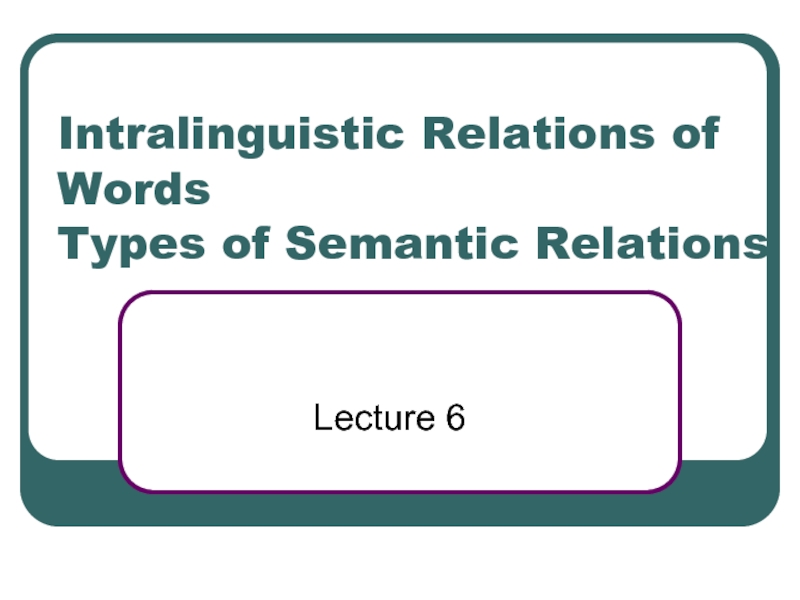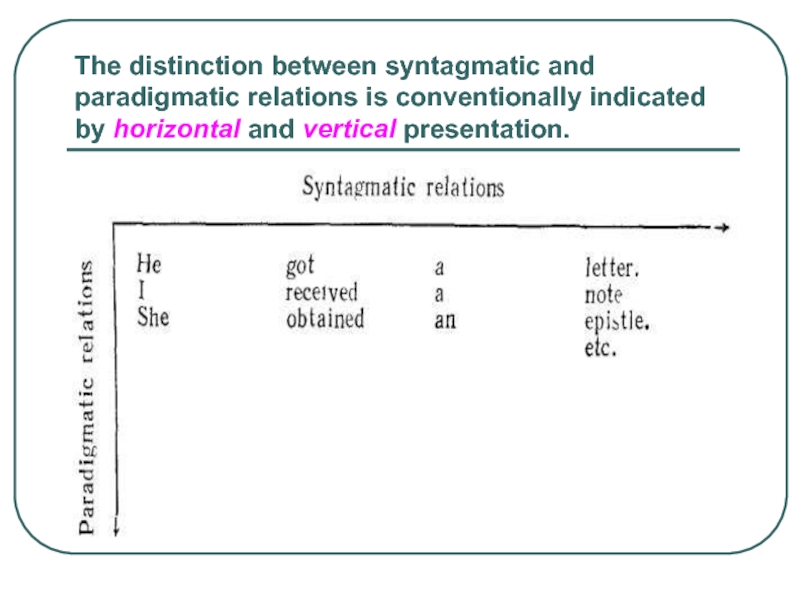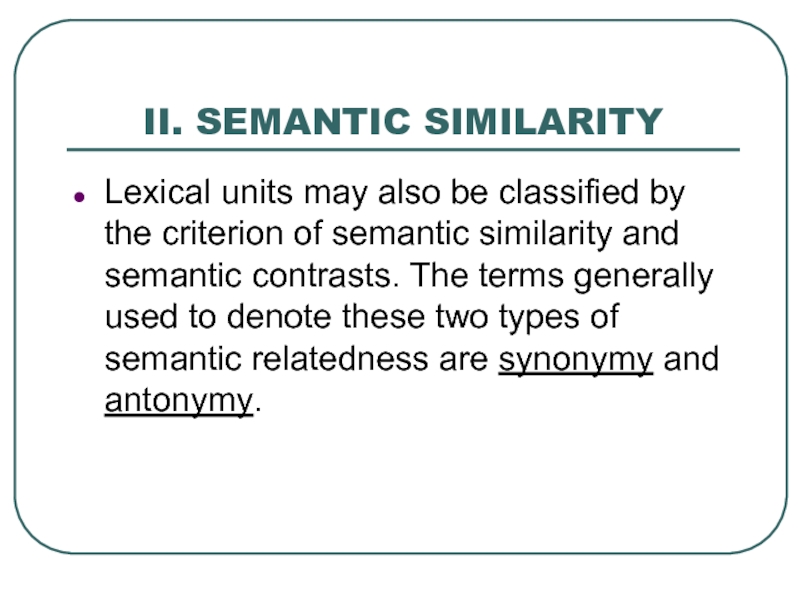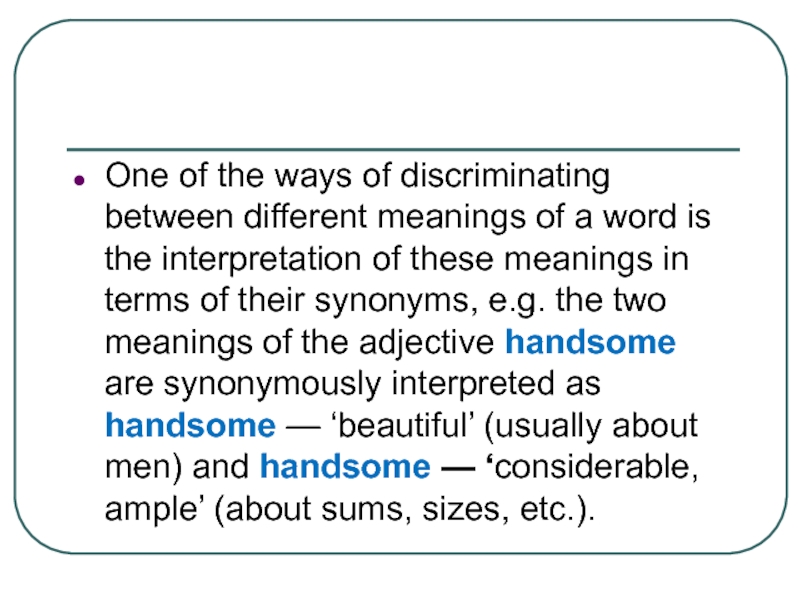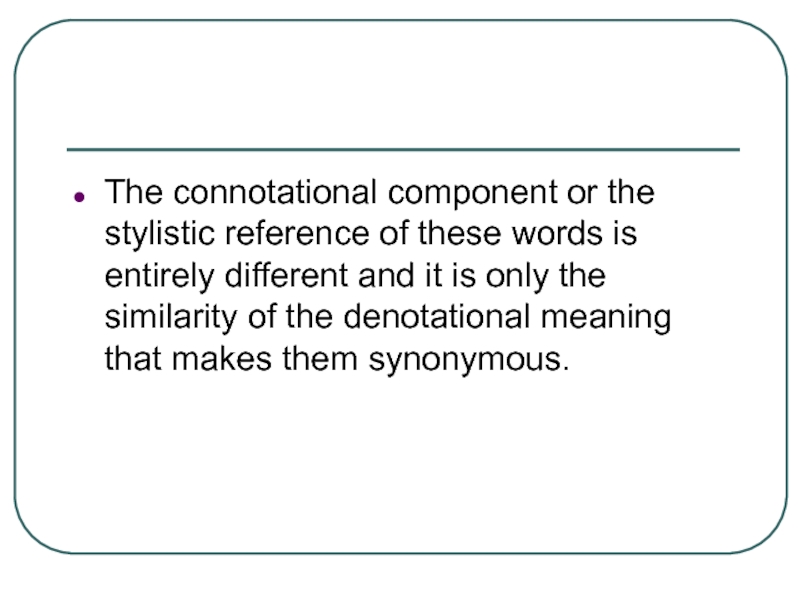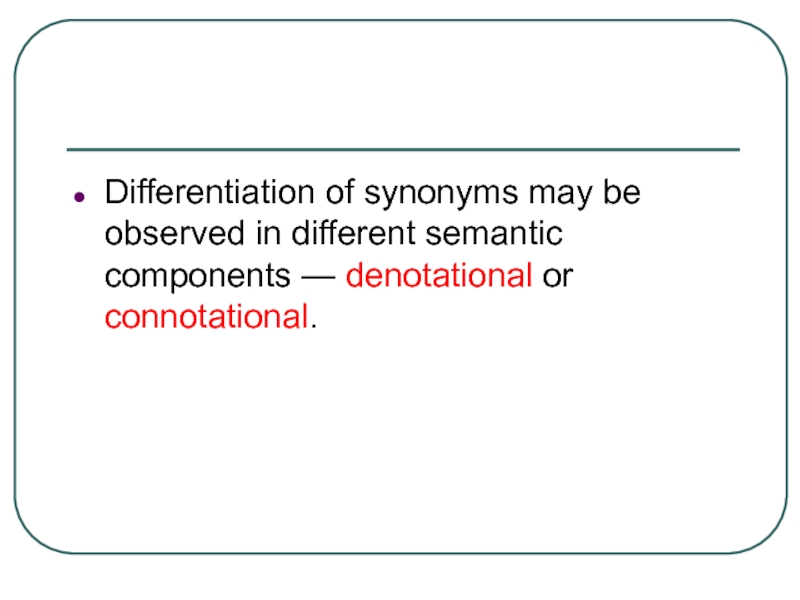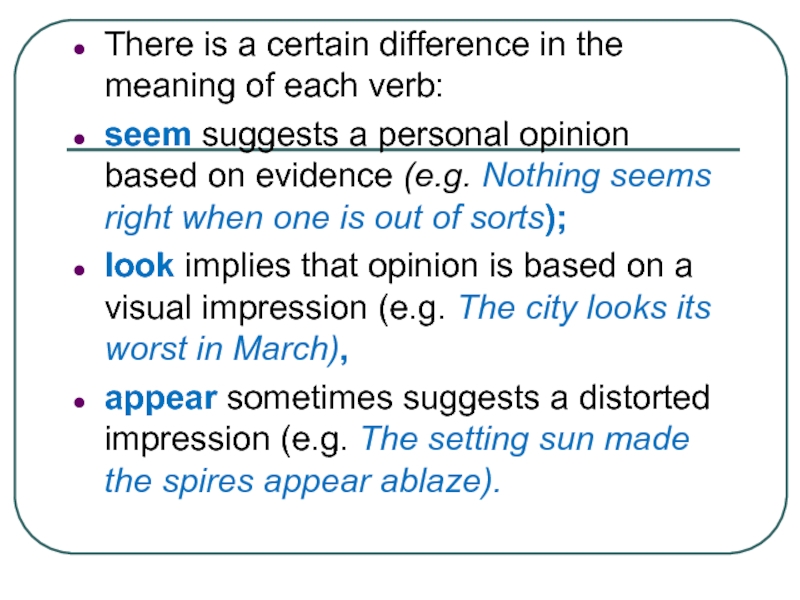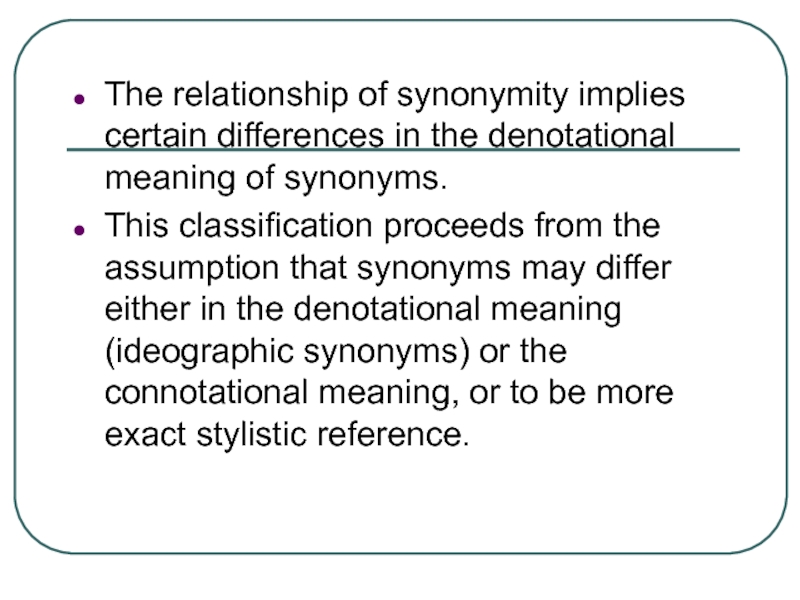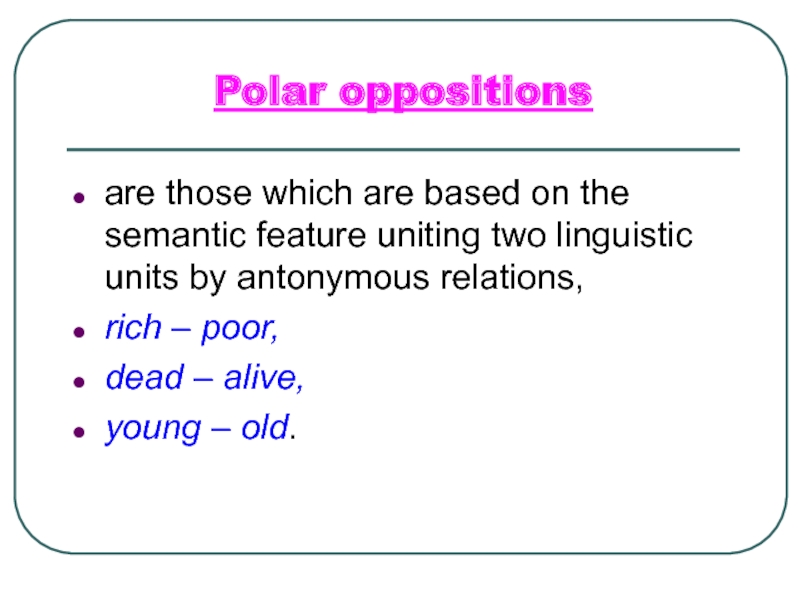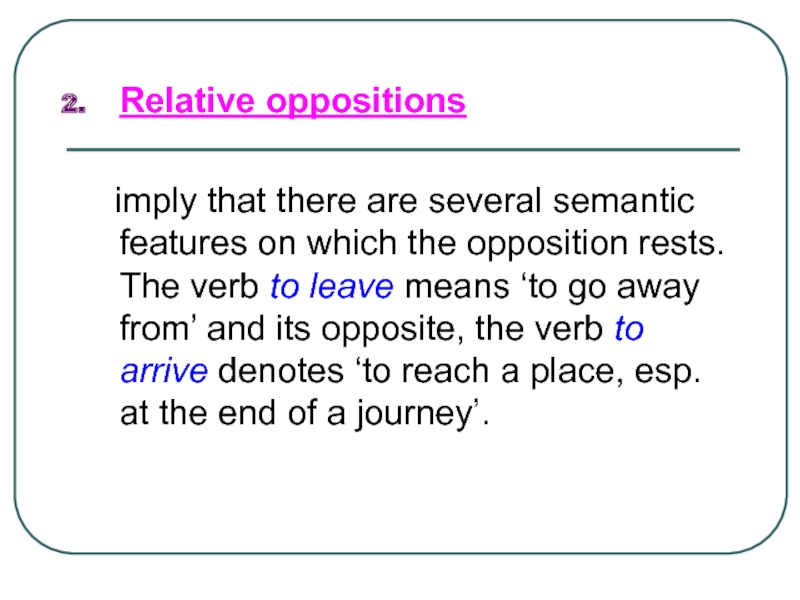Разделы презентаций
- Разное
- Английский язык
- Астрономия
- Алгебра
- Биология
- География
- Геометрия
- Детские презентации
- Информатика
- История
- Литература
- Математика
- Медицина
- Менеджмент
- Музыка
- МХК
- Немецкий язык
- ОБЖ
- Обществознание
- Окружающий мир
- Педагогика
- Русский язык
- Технология
- Физика
- Философия
- Химия
- Шаблоны, картинки для презентаций
- Экология
- Экономика
- Юриспруденция
Intralinguistic Relations of Words Types of Semantic Relations
Содержание
- 1. Intralinguistic Relations of Words Types of Semantic Relations
- 2. INTRALINGUISTIC RELATIONS OF WORDSSYNTAGMATIC RELATIONSPARADIGMATIC RELATIONSSEMANTIC SIMILARITYSEMANTIC CONTRASTBASIC TYPES OF SEMANTIC RELATIONS PROXIMITYEQUIVALENCEINCLUSION. HYPONYMIC STRUCTURESOPPOSITION.
- 3. I. Intralinguistic Relations of WordsFerdinand de Saussure:Intralinguistic
- 4. 1.1. Syntagmatic Relations - are the relationships that
- 5. syntagmatic relations are linear relations between wordsThe
- 6. Context - the minimal stretch of speech
- 7. 1.2. PARADIGMATIC REALTIONS - are the relations that
- 8. The distinction between syntagmatic and paradigmatic relations is conventionally indicated by horizontal and vertical presentation.
- 9. II. SEMANTIC SIMILARITYLexical units may also be
- 10. Similar relations between word-groups and sentences are
- 11. Synonyms are traditionally described as words different
- 12. Firstly, it seems impossible to speak of
- 13. The verb look, is usually treated as
- 14. One of the ways of discriminating between
- 15. Secondly,it seems impossible to speak of identity
- 16. The connotational component or the stylistic reference
- 17. The words, e.g. to die, to walk,
- 18. Thirdly,it does not seem possible to speak
- 19. Words in synonymic sets are in general
- 20. Thus it seems necessary to modify the
- 21. Differentiation of synonyms may be observed in different semantic components — denotational or connotational.
- 22. The difference in denotational meaning cannot exceed
- 23. The verbs look, seem, appear, e.g., are
- 24. There is a certain difference in the
- 25. The relationship of synonymity implies certain differences
- 26. This assumption cannot be accepted as synonymous
- 27. That department of an institution which is
- 28. This fact may be explained as follows:
- 29. Secondly, interchangeability alone cannot serve as a
- 30. Thus a more acceptable definition of synonyms
- 31. III. SEMANTIC CONTRASTAntonymy in general shares many
- 32. The term opposite meaning is rather vague
- 33. Comparing the adjective kind and unkind we
- 34. II. BASIC TYPES OF SEMANTIC RELATIONS 2.1.
- 35. The adjectives are characterized by certain features
- 36. Semantic Proximityred and green share the semantic
- 37. 2.2. Equivalenceimplies full similarity of meaning of
- 38. 2.3. INCLUSION. HYPONYMIC STRUCTURE - type of semantic
- 39. The general term – vehicle, tree, animal
- 40. In hyponymic structure certain words may be
- 41. The principle of such hierarchical classification is
- 42. Personsadults (man, woman, husband, etc.);children (boy, girl,
- 43. The problem of great importance for linguists
- 44. In English
- 45. 2.4. OPPOSITION -is the contrast of semantic
- 46. Polar oppositions are those which are based
- 47. Relative oppositions imply that there are several
- 48. Summary and Conclusions:1. Paradigmatic (or selectional) and
- 49. On the syntagmatic axis the word-meaning is
- 50. Linguistic (verbal) contexts comprise lexical and grammatical
- 51. The semantic structure of polysemantic words is
- 52. Synonymy and antonymy are correlative and sometimes
- 53. It is suggested that the term synonyms
- 54. The term antоnуms is to be applied
- 55. References:Гинзбург Р.З. Лексикология английского языка. М. Высшая
- 56. Скачать презентанцию
INTRALINGUISTIC RELATIONS OF WORDSSYNTAGMATIC RELATIONSPARADIGMATIC RELATIONSSEMANTIC SIMILARITYSEMANTIC CONTRASTBASIC TYPES OF SEMANTIC RELATIONS PROXIMITYEQUIVALENCEINCLUSION. HYPONYMIC STRUCTURESOPPOSITION.
Слайды и текст этой презентации
Слайд 2INTRALINGUISTIC RELATIONS OF WORDS
SYNTAGMATIC RELATIONS
PARADIGMATIC RELATIONS
SEMANTIC SIMILARITY
SEMANTIC CONTRAST
BASIC TYPES OF
SEMANTIC RELATIONS
Слайд 3I. Intralinguistic Relations of Words
Ferdinand de Saussure:
Intralinguistic relations exist between
words
They are basically of two types: syntagmatic and paradigmatic
Слайд 41.1. Syntagmatic Relations -
are the relationships that a linguistic unit
has with other units in the stretch of speech in
which it occurs.He got a letter (to receive);
He got tired (to become);
He got to London (to arrive);
He could not get the piano through the door (to move smth. to or from a position or place).
Слайд 5syntagmatic relations are linear relations between words
The adjective yellow:
colour: a
yellow dress;
envious, suspicious: a yellow look;
corrupt: the yellow press
Слайд 6Context - the minimal stretch of speech determining each individual
meaning of the word.
free or denominative meanings - the
meaning or meanings representative of the semantic structure of the word and least dependent on context:table – a piece of furniture;
make - construct, produce’
Слайд 71.2. PARADIGMATIC REALTIONS -
are the relations that a linguistic unit
has with units by which it may be replaced: sets
of synonyms, pairs of antonyms, lexico-semantic groups, etc.E.G. to get synonymic set: to obtain, to receive, to gain, to acquire, etc.
Слайд 8The distinction between syntagmatic and paradigmatic relations is conventionally indicated
by horizontal and vertical presentation.
Слайд 9II. SEMANTIC SIMILARITY
Lexical units may also be classified by the
criterion of semantic similarity and semantic contrasts. The terms generally
used to denote these two types of semantic relatedness are synonymy and antonymy.Слайд 10Similar relations between word-groups and sentences are described as semantic
equivalence.
Synonyms may be found in different parts of speech
and both among notional and function words. For example, though and albeit, on and upon, since and as are synonymous because these phonemically different words are similar in their denotational meaning.Слайд 11Synonyms are traditionally described as words different in sound-form but
identical or similar in meaning.
This definition has been severely
criticised on many points. Слайд 12Firstly,
it seems impossible to speak of identical or similar
meaning of words as such as this part of the
definition cannot be applied to polysemantic words. It is inconceivable that polysemantic words could be synonymous in all their meanings.Слайд 13The verb look, is usually treated as a synonym of
see, watch, observe, etc., but in another of its meanings
it is not synonymous with this group of words but rather with the verbs seem, appear (cf. to look at smb and to look pale).The number of synonymic sets of a polysemantic word tends as a rule to be equal to the number of individual meanings the word possesses.
Слайд 14One of the ways of discriminating between different meanings of
a word is the interpretation of these meanings in terms
of their synonyms, e.g. the two meanings of the adjective handsome are synonymously interpreted as handsome — ‘beautiful’ (usually about men) and handsome — ‘considerable, ample’ (about sums, sizes, etc.).Слайд 15Secondly,
it seems impossible to speak of identity or similarity of
lexical meaning as a whоle as it is only the
denotational component that may be described as identical or similar. If we analyse words that are usually considered synonymous, e.g. to die, to pass away; to begin, to commence, etc.,Слайд 16The connotational component or the stylistic reference of these words
is entirely different and it is only the similarity of
the denotational meaning that makes them synonymous.Слайд 17The words, e.g. to die, to walk, to smile, etc.,
may be considered identical as to their stylistic reference or
emotive charge, but as there is no similarity of denotational meaning they are never felt as synonymous words.Слайд 18Thirdly,
it does not seem possible to speak of identity of
meaning as a criterion of synonymity since identity of meaning
is very rare even among monosemantic words.Cases of complete synonymy are very few and are confined to technical nomenclatures where we can find monosemantic terms completely identical in meaning as, for example, spirant and fricative in phonetics.
Слайд 19Words in synonymic sets are in general differentiated because of
some element of opposition in each member of the set.
The word handsome, e.g., is distinguished from its synonym beautiful mainly because the former implies the beauty of a male person or broadly speaking only of human beings, whereas beautiful is opposed to it as having no such restrictions in its meaning.Слайд 20Thus
it seems necessary to modify the traditional definition and
to formulate it as follows: synonyms are words different in
sound-form but similar in their denotational meaning or meanings. Synonymous relationship is observed only between similar denotational meanings of phonemically different words.Слайд 21Differentiation of synonyms may be observed in different semantic components
— denotational or connotational.
Слайд 22The difference in denotational meaning cannot exceed certain limits, and
is always combined with some common denotational component.
Слайд 23The verbs look, seem, appear, e.g., are viewed as members
of one synonymic set as all three of them possess
a common denotational semantic component “to be in one’s view, or judgement, but not necessarily in fact” and come into comparison in this meaning (cf. he seems (looks), (appears), tired).Слайд 24There is a certain difference in the meaning of each
verb:
seem suggests a personal opinion based on evidence (e.g.
Nothing seems right when one is out of sorts); look implies that opinion is based on a visual impression (e.g. The city looks its worst in March),
appear sometimes suggests a distorted impression (e.g. The setting sun made the spires appear ablaze).
Слайд 25The relationship of synonymity implies certain differences in the denotational
meaning of synonyms.
This classification proceeds from the assumption that
synonyms may differ either in the denotational meaning (ideographic synonyms) оr the connotational meaning, or to be more exact stylistic reference.Слайд 26This assumption cannot be accepted as synonymous words always differ
in the denotational component.
Thus buy and purchase are similar
in meaning but differ in their stylistic reference and therefore are not completely interchangeable. Слайд 27That department of an institution which is concerned with acquisition
of materials is normally the Purchasing Department rather than the
*Buying Department.A wife however would rarely ask her husband to purchase a pound of butter. It follows that practically no words are substitutable for one another in all contexts.
Слайд 28This fact may be explained as follows: firstly, words synonymous
in some lexical contexts may display no synonymity in others.
The comparison of the sentences The rainfall in April was abnormal and The rainfall in April was exceptional may give us grounds for assuming that exceptional and abnormal are synonymous.
The same adjectives in a different context are by no means synonymous, as we may see by comparing My son is exceptional and My son is abnormal.
Слайд 29Secondly, interchangeability alone cannot serve as a criterion of synonymity.
Synonyms are words interchangeable in some contexts. But the reverse
is certainly not true as semantically different words of the same part of speech are, as a rule, interchangeable in quite a number of contexts: in the sentence I saw a little girl playing in the garden
the adjective little may be formally replaced by a number of semantically different adjectives, e.g. pretty, tall, English, etc.
Слайд 30Thus a more acceptable definition of synonyms :
synonyms are
words different in their sound-form, but similar in their denotational
meaning or meanings and interchangeable at least in some contexts.Слайд 31III. SEMANTIC CONTRAST
Antonymy in general shares many features typical of
synonymy.
Perfect or complete antonyms are fairly rare.
The relations of
antonymy restricted to certain contexts. Thus thick is only one of the antonyms of thin (a thin slice—a thick slice), another is fat (a thin man—a fat man).Слайд 32The term opposite meaning is rather vague and allows of
essentially different interpretation.
kind — ‘gentle, friendly, showing love, sympathy or
thought for others’ and cruel — ‘taking pleasure in giving pain to others, without mercy’, They denote concepts that are felt as completely opposed to each other.
Слайд 33Comparing the adjective kind and unkind we do not find
any polarity of meaning as here semantic opposition is confined
to simple negation.Unkind may be interpreted as not kind which does not necessarily mean cruel, just as not beautiful does not necessarily mean ugly.
Слайд 34II. BASIC TYPES OF SEMANTIC RELATIONS
2.1. PROXIMITY
Meaning similarity is
seldom complete and nearly always partial which makes it possible
to speak about the semantic proximity of words and, in general, about the relations of semantic proximity.Слайд 35The adjectives are characterized by certain features of semantic dissimilarity
which shows that they are not absolutely identical in meaning
Слайд 36Semantic Proximity
red and green share the semantic features of ‘colour’,
‘basic or rainbow colour’, ‘complementary colour,;
red vs scarlet or green
vs emerald may be graded in semantic proximity;table and chair share the semantic features of ‘thingness’, ‘object’, ‘piece of furniture’ that forms a good basis for grouping them together with other nouns denoting ‘pieces of furniture’.
Слайд 372.2. Equivalence
implies full similarity of meaning of two or more
language units;
is very seldom observed in words;
Is oftener encountered
in case of sentences:John is taller than Bill = Bill is shorter than John.
She lives in Paris = She lives in the capital of France.
Слайд 382.3. INCLUSION. HYPONYMIC STRUCTURE -
type of semantic relations which exists
between two words if the meaning of one word contains
the semantic features ‘constituting the meaning of the other word’.The semantic relations of inclusion are called hyponymic relations:
Vehicle: car, lorry, motorcycle, jeep…
Hyperonym: hyponyms.
Слайд 39The general term – vehicle, tree, animal – is referred
to as the classifier or the hyperonym.
The specific term
is called the hyponym (car, tram; oak, ash; cat; tiger). The more specific term (the hyponym) is included in the more general term (the hyperonym), e.g. the classifier move and members of the group – walk, run, saunter. The individual terms contain the meaning of the general term in addition to their individual meanings which distinguish them from each other.
Слайд 40In hyponymic structure certain words may be both classifiers (hyperonyms)
and members of the group (hyponyms):
Слайд 41The principle of such hierarchical classification is widely used by
scientists in various fields of research: botany, geology, etc.
Hyponymic
classification may be viewed as objectively reflecting the structure of vocabulary and is considered by many linguists as one of the most important principles for the description of meaning.Слайд 42Persons
adults (man, woman, husband, etc.);
children (boy, girl, lad, etc.) but
also
national groups (American, Russian, Chinese, etc.),
professional groups (teacher, butcher,
baker, etc.), social and economic groups, and so on.
Слайд 43The problem of great importance for linguists is the dependence
of the hierarchical structures of lexical units not only on
the structure of the corresponding group of referents in real world but also on the structure of vocabulary in this or that language.Слайд 44In English in Russian LSV
no word for meals: meals
breakfast,
lunch,
dinner,
supper,
snack etc,
завтрак
обед
полдник
ужин
Слайд 452.4. OPPOSITION -
is the contrast of semantic features which helps
to establish the semantic relations (black is contrasted to white).
The relations of opposition imply the exclusion of the meaning of one word by another (black is opposed to white but it is not opposed to either red or yellow. In the latter case we can speak about contrast of meaning, but not the semantic relations of opposition.
Слайд 46Polar oppositions
are those which are based on the semantic
feature uniting two linguistic units by antonymous relations,
rich –
poor, dead – alive,
young – old.
Слайд 47Relative oppositions
imply that there are several semantic features on
which the opposition rests. The verb to leave means ‘to
go away from’ and its opposite, the verb to arrive denotes ‘to reach a place, esp. at the end of a journey’.Слайд 48Summary and Conclusions:
1. Paradigmatic (or selectional) and syntagmatic (or combinatory)
axes of linguistic structure represent the way vocabulary is organised.
Syntagmatic
relations define the word-meaning in the flow of speech in various contexts.Paradigmatic relations define the word-meaning through its interrelation with other members within one of the subgroups of vocabulary units.
